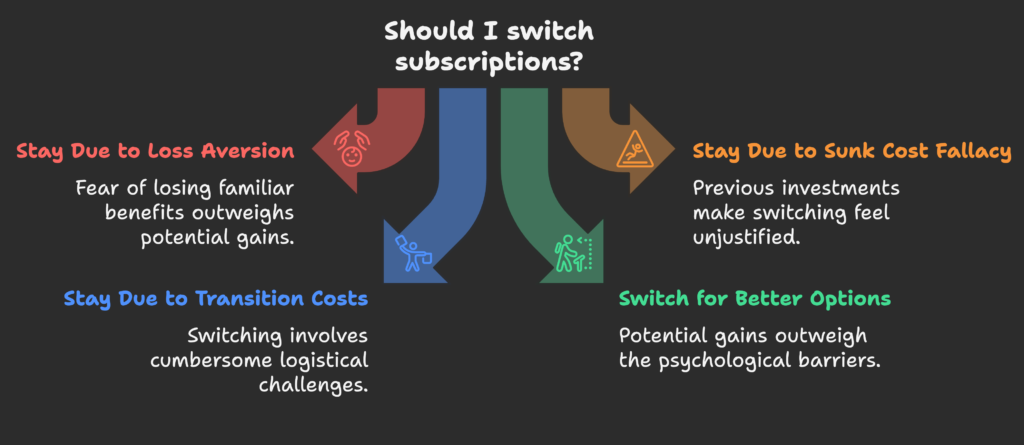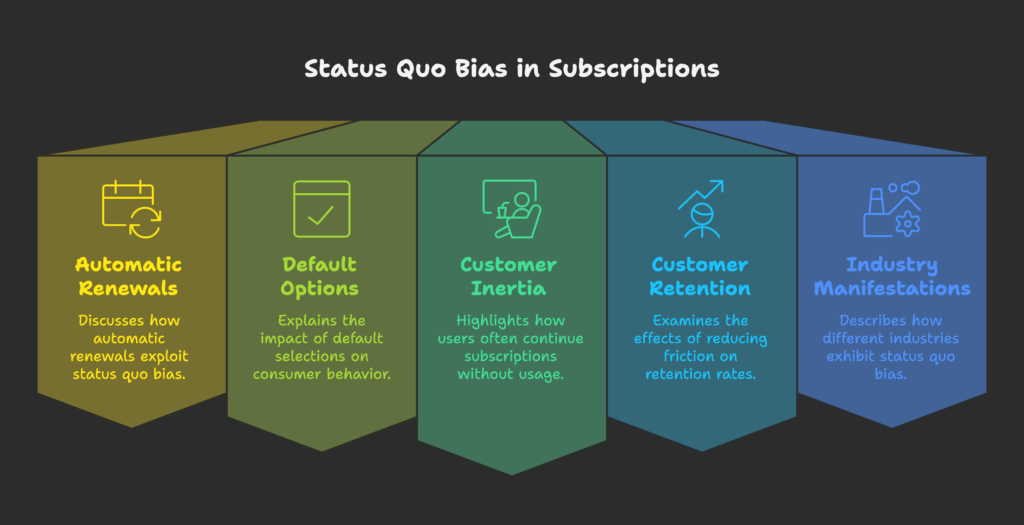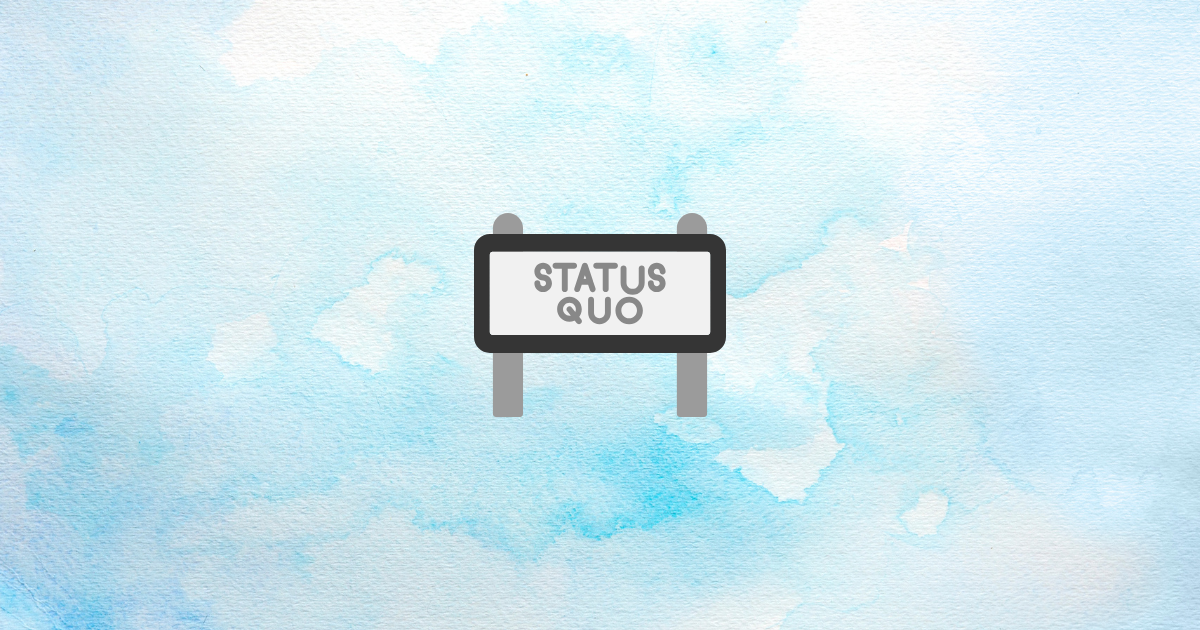Have you ever stuck with a subscription service long after you stopped using it, just because switching felt like a hassle? Or perhaps you found yourself paying for a streaming platform you barely remember signing up for, yet you continue paying every month. If these scenarios sound familiar, you’ve encountered status quo bias in action.
In this article, you’ll learn what status quo bias is, why it plays such a key role in subscription-based businesses, and how you can either leverage it if you’re an established player—or overcome it if you’re new to the market. Ready to dive in? Let’s get started.
What to Expect in This Section: We’ll clarify the basics of status quo bias, explore the booming subscription economy, and discuss why this psychological tendency matters so much for e-commerce businesses.
Definition and Fundamentals of Status Quo Bias
Status quo bias is the tendency to keep things the same, often due to perceiving any change as a potential loss. People view their current subscription or service as the baseline, so switching feels like giving up something—even if the new option offers clear benefits.
The Subscription Economy: Current Landscape and Growth Trends
The subscription market is growing faster than ever. From streaming services to meal kits, consumers now have a subscription for almost everything. Statistics show consistent double-digit growth rates year over year, revealing how people have grown comfortable paying monthly or yearly for ongoing value. This vast popularity makes status quo bias even more critical—once people start a subscription, they often keep it longer than they intend.
Why Status Quo Bias Matters in Subscription-Based Business Models
Research suggests that around 72% of subscribers continue with automatic renewals because sticking with what’s familiar is easier than making a change. For businesses, this inertia means reliable income and higher customer retention. However, it also poses challenges for new entrants looking to break through that psychological wall.
The Paradox: Benefiting from Status Quo Bias as an Incumbent vs. Overcoming It as a New Entrant
Established brands get to enjoy customers who don’t want to switch away from what they know, but new players face the uphill task of convincing those same customers to risk a change. Throughout this article, you’ll see strategies for both leveraging this bias if you’re an incumbent and breaking it if you’re launching a fresh subscription service.
Now that we’ve set the stage, let’s dig deeper into the psychological roots of status quo bias. Ready?
The Psychological Foundations of Status Quo Bias
What to Expect in This Section: We’ll explore the mental shortcuts and cognitive traps that lead us to avoid switching, even when better options exist.

Cognitive Misperception and Loss Aversion
Human beings often feel potential losses more intensely than equivalent gains. This makes the risk of losing a familiar service feel greater than the reward of gaining a new one. So even if a subscription switch promises more features at a better price, the fear of losing comfort keeps us from acting.
Psychological Commitment and Sunk Cost Fallacy
We tend to overvalue what we’ve already invested time, effort, or money into—this is the sunk cost fallacy. When we pay for a subscription, we feel compelled to stay with it “to get our money’s worth,” even if we’re no longer benefiting.
Rational Decision-Making and Transition Costs
On a purely logical level, switching subscriptions can involve setting up new payment plans, transferring data, or learning a new interface. These transition costs add up, making the switch feel like a bigger deal than it truly is, and reinforcing our status quo bias.
Related Cognitive Biases (Endowment Effect, Mere Exposure Effect, Existence Bias)
- Endowment Effect: We value things more once we own them.
- Mere Exposure Effect: Familiarity breeds preference.
- Existence Bias: We assume current or existing options must be better simply because they already exist.
All these biases work together to keep people subscribed to the same services month after month.
Neurological Basis for Status Quo Preference
Studies indicate our brains respond to uncertainty with caution, triggering neural pathways associated with risk. Meanwhile, dopamine often rewards us for sticking with familiar routines. This hardwiring makes “staying put” more appealing than exploring the unknown.
Now that we understand the mental mechanics, let’s see how they play out in real subscription scenarios.
How Status Quo Bias Manifests in Subscription Models
What to Expect in This Section: We’ll look at the design elements and metrics that highlight how deeply status quo bias is woven into the subscription experience.

Automatic Renewals and Friction in Cancellation Processes
Automatic renewals capitalize on status quo bias by continuing service without requiring action. Meanwhile, cancellation processes can be intentionally or unintentionally cumbersome, creating friction that deters people from canceling.
The Power of Default Options
Consumers often accept default selections simply because it takes extra effort to change them. In subscriptions, a pre-checked “renew automatically” box is highly effective at keeping customers locked in.
Customer Inertia in Digital Subscription Services
The path of least resistance is to do nothing, leading many users to keep paying for services they rarely use—be it a streaming platform or a software tool that’s only opened once a month.
Measurable Effects on Customer Retention and Lifetime Value
Data shows that reducing friction in onboarding and renewal can dramatically increase the average customer’s lifetime value. Status quo bias is a powerful part of this, ensuring that most customers stick around unless given a strong reason to leave.
Industry-Specific Manifestations (Streaming, Software, Physical Products, etc.)
Streaming subscribers might resist switching to a new platform because they’ve already curated a watchlist. Software users may dread learning another interface. Physical product subscribers (like weekly meal kits) might feel locked into a routine even if they’re not always enjoying the meals. Different industries, same psychological force.
So, how does this all affect brand-new subscription services trying to break into the market? Let’s check that out next.
Challenges for New Entrants in Subscription Markets
What to Expect in This Section: We’ll dive into the hurdles newcomers face, from trust-building to resource constraints.
Competing Against Established Subscription Services
Well-known brands have a head start because consumers feel safer sticking with something they recognize. New entrants must work harder to prove credibility and reliability.
The “If It Ain’t Broke, Don’t Fix It” Mentality
Consumers who see no glaring problem with their current subscription often ignore alternatives. This makes it an uphill battle for new services to highlight how they can improve lives or save money.
Overcoming Initial Resistance to Change
Getting people to take a free trial or sign up for a demo can be difficult if they already think they have everything they need. Breaking that initial wall is one of the toughest tasks in subscription marketing.
Building Trust as a Newcomer Against Familiar Alternatives
Users are cautious about unfamiliar brands, especially when their monthly payments or personal data are involved. Trust-building content, transparent policies, and strong testimonials can help ease these concerns.
Resource Asymmetry Between Incumbents and Challengers
Big names often have larger marketing budgets, more robust infrastructures, and existing user bases. Small or new brands must get creative, focusing on specific niche benefits or compelling offers to compete.
Seeing the obstacles is only half the story. What about the consumer’s perspective on status quo bias? Let’s find out.
Consumer Perspective: The Downside of Status Quo Bias
What to Expect in This Section: We’ll shift to the customer’s point of view and explore the costs of staying with the familiar.
Continued Payment for Underutilized Services
Many people pay for services they rarely use, whether it’s a gym membership or a gaming subscription. They hold on due to fear of missing out or the guilt of “wasted” money if they cancel.
Missed Opportunities for Better Alternatives
Status quo bias can blind consumers to newer, cheaper, or more innovative options. They might lose out on better features or savings simply because switching feels risky.
Financial Impact of Unnecessary Subscriptions
Small recurring fees can add up. Research shows an average consumer may be spending considerable amounts yearly on subscriptions that bring little or no real value.
Decision Fatigue and Choice Overload in Subscription Management
With countless subscription services available, evaluating each one can be exhausting. This leads to paralysis, causing people to stick with what they already have rather than explore new possibilities.
Consumer Awareness and Education About Their Own Biases
Helping customers understand their mental habits can be empowering. Tools or articles that reveal the psychology behind status quo bias might encourage them to become more deliberate about their subscriptions.
Is it fair for businesses to exploit these biases? Let’s think about the ethical side next.
Ethical Considerations in Subscription Design
What to Expect in This Section: We’ll discuss the moral responsibilities businesses have when designing subscription models that leverage our psychological tendencies.
Dark Patterns vs. Consumer-Friendly Design
Dark patterns intentionally make it hard to cancel or change a service, taking advantage of user inertia. Meanwhile, consumer-friendly design respects user autonomy and offers straightforward cancellation paths.
Transparency in Subscription Terms and Renewal Policies
Being open about renewal dates, price changes, and cancellation options builds long-term trust. Hiding these details erodes credibility and can harm brand reputation over time.
Balancing Business Interests with Consumer Welfare
It’s a balancing act: companies need revenue and retention, but they also need to avoid exploiting customers unfairly. Ethical subscription design finds a middle ground where both parties benefit.
Regulatory Landscape and Compliance Requirements
Certain regions have laws requiring businesses to clearly disclose recurring charges or make cancellations easy. Staying compliant protects consumers and can also build brand goodwill.
Building Long-Term Trust vs. Short-Term Retention
Some businesses use aggressive tactics to retain subscribers, but this can backfire if customers feel tricked. Honest, user-centric approaches may reduce immediate churn but lead to a stronger, more reputable brand.
So if you’re a newcomer aiming to break through this bias, what can you do? Let’s see some practical strategies.
Strategies for Overcoming Status Quo Bias as a New Entrant
What to Expect in This Section: We’ll explore actionable techniques to help fresh subscription services stand out and encourage users to switch.
Framing Techniques to Minimize Perceived Losses
Highlight what customers gain by switching, rather than what they’re giving up. Emphasize new features, potential cost savings, and real-life benefits to reframe the choice as an upgrade, not a sacrifice.
Reducing Transition Costs and Friction
Make it easy to import data, transfer profiles, or manage payments. The simpler your onboarding, the less chance status quo bias has to kick in.
Creating Compelling Differentiation and Value Proposition
Offer something the incumbent doesn’t—like personalized content, unique features, or superior customer service—so prospects feel they’d miss out by not switching.
Leveraging Free Trials and Money-Back Guarantees
This approach lowers the perceived risk of trying something new. People are more willing to test a new service if they know they can revert without penalty.
Social Proof and Testimonials to Reduce Uncertainty
Display reviews and success stories from relatable customers who have switched. Hearing from peers who overcame the same hesitations can be very persuasive.
Educational Content to Highlight Status Quo Costs
Blog posts, infographics, or videos that show how remaining with an outdated service might cost more money or time can push users to reconsider their choices.
Strategic Timing for Market Entry and Customer Acquisition
People are more receptive to changes during specific life or business stages—like moving to a new home, starting a new job, or during a major product update from an incumbent. Seize those windows for your marketing.
Beyond strategy, technology plays a key role. Let’s see how.
Technological Solutions for Status Quo Disruption
What to Expect in This Section: We’ll explore how tech innovations reduce switching friction and create more personalized user experiences.
One-Click Migration Tools and Services
By automating most of the switch process, these tools help customers import settings or data in just a few clicks, making the decision to switch far less stressful.
AI-Powered Personalization to Enhance Perceived Value
Machine learning can tailor the user experience, offering personalized recommendations or interfaces. When customers see content and product suggestions that fit their preferences, the incentive to switch to your service increases.
Subscription Management Platforms as Disruptive Tools
Third-party services that track and manage all your subscriptions in one place can reveal underused apps or better deals. These platforms can prompt users to explore new services more readily.
Blockchain and Decentralized Subscription Models
Though still emerging, blockchain could someday offer transparent, user-controlled subscription structures. This could lower the trust barrier for switching if transactions and terms are crystal-clear.
Interoperability Standards and Open Ecosystems
When companies adopt standards that make it easy to move from one service to another, subscribers gain the freedom to switch with less hassle. This fosters healthier competition and innovation.
Now let’s move from technology to marketing, because sometimes the biggest factor in overcoming bias is your messaging.
Marketing Strategies to Challenge the Status Quo
What to Expect in This Section: We’ll cover messaging and promotion tactics that can sway consumers to consider switching.
Comparative Marketing Approaches
Show potential customers a side-by-side comparison of your features versus the incumbent’s. Highlight clear benefits—like lower cost or better functionality—to spark interest.
Loss-Framing in Marketing Messages
Rather than just showing benefits, emphasize what a customer loses by sticking with the old subscription. This taps into their natural aversion to losing out on something valuable.
Creating FOMO (Fear of Missing Out) for Non-Adopters
Social proof and community spotlights can make your service feel like a must-have. If people sense everyone else is switching, they’ll be more inclined to follow suit.
Community Building and Network Effects
A strong community can add an emotional incentive to switch. Users don’t just gain a product; they join a group of like-minded individuals, further reducing the perceived risk of change.
Strategic Partnerships to Enhance Credibility
Teaming up with well-known brands or influencers helps you borrow some of their trust and reputation. This instantly lowers barriers for skeptical customers.
Content Marketing to Educate About Hidden Costs of Status Quo
From blog posts to webinars, educational materials that quantify the real costs of staying put can nudge potential subscribers toward change.
To see these strategies in action, we should look at some success stories—and a few cautionary tales.
Case Studies: Successful Disruption of Subscription Markets
What to Expect in This Section: We’ll explore how certain brands overcame powerful incumbents, and where others fell short.
Netflix vs. Traditional Cable
Netflix reimagined how we consume TV and movies. By offering on-demand streaming without complex contracts, they disrupted cable’s status quo. The simplicity and convenience were so appealing that many viewers felt they had little to lose by switching.
Spotify vs. iTunes/Music Ownership Model
Spotify challenged the norm of purchasing individual songs by introducing a subscription-based approach to unlimited streaming. People had to overcome their attachment to “owning” music, but Spotify’s extensive library and user-friendly interface made switching enticing.
Dollar Shave Club vs. Traditional Razor Market
By directly shipping affordable razor subscriptions, Dollar Shave Club took on established consumer goods giants. They used bold marketing to highlight the inconvenience and higher cost of buying razors in traditional stores.
Software-as-a-Service Disruptors in Enterprise Markets
Companies like Salesforce showed big businesses that paying monthly for cloud-based software could offer more flexibility and constant updates compared to buying expensive, one-time licenses.
Subscription Box Services Creating New Categories
Some subscription box services faced fewer status quo hurdles because they introduced entirely new habits—like discovering niche snacks or beauty products—rather than competing against an entrenched option.
Analysis of Failed Attempts to Overcome Status Quo Bias
Not every venture succeeds. Some services lacked a compelling enough reason to switch or failed to address user concerns about reliability. Their struggle underlines the importance of value differentiation and ease of transition.
Now that we have real-world inspiration, how do we measure our efforts to break the status quo?
Measuring and Testing Strategies Against Status Quo Bias
What to Expect in This Section: We’ll look at how data, experiments, and the right metrics can reveal if your strategies are working.
A/B Testing Frameworks for Subscription Acquisition
Run controlled experiments on your sign-up pages or pricing models. By comparing different versions, you can discover which designs or messages best convert hesitant visitors.
Key Performance Indicators for Status Quo Disruption
Go beyond simple conversion rates. Look at metrics like “switch conversion rate,” the number of users coming from a competitor, or churn rates for newly acquired customers.
Customer Research Methodologies to Identify Status Quo Factors
Surveys, interviews, and focus groups can help you uncover exactly why customers hesitate to switch. Tackle those pain points directly with your product or marketing.
Behavioral Economics Experiments in Subscription Design
Consider small, controlled experiments where you manipulate elements like default settings or risk-free trials. Observing behavior changes can guide improvements to your subscription model.
Long-Term vs. Short-Term Measurement Considerations
You might see an initial spike in sign-ups from curious users, but long-term loyalty determines real success. Keep tracking engagement and satisfaction levels over time to see if you’re truly breaking the status quo.
Where do we go from here? Let’s look at the future and how evolving consumer attitudes might shape subscription markets.
Future Trends in Subscription Models and Status Quo Bias
What to Expect in This Section: We’ll peek into emerging consumer habits, new technologies, and how they could change the subscription landscape.
Evolution of Consumer Attitudes Toward Subscriptions
Younger generations may be more open to switching as they embrace digital services from an early age. However, they also expect seamless experiences and may drop a subscription quickly if it doesn’t meet their standards.
Impact of Subscription Fatigue on Status Quo Dynamics
As people subscribe to more and more services, they can feel overwhelmed. This fatigue can make them cling harder to a few “core” subscriptions they trust, raising the barrier for new entrants.
Emerging Technologies That May Disrupt Current Paradigms
Technologies like augmented reality, virtual reality, or advanced AI tools might reshape how people perceive value in subscriptions, potentially encouraging them to explore new types of services.
Predictive Analytics and Personalized Subscription Experiences
Future platforms may anticipate individual user needs more accurately, offering personalized bundles that proactively address pain points. This could break the grip of older, one-size-fits-all incumbents.
Sustainability and Ethical Considerations in Future Models
Eco-conscious and socially responsible consumer trends could further influence switching. If customers see an incumbent as unethical or wasteful, they might be more willing to take a chance on a challenger that aligns with their values.
Now, let’s bring it all together and consider the key takeaways for subscription businesses.
Conclusion and Strategic Implications
What to Expect in This Section: We’ll tie together all the insights on status quo bias and lay out practical recommendations for subscription leaders.
Balancing Status Quo Leveraging and Disruption
Incumbents can benefit from making subscriptions effortless and rewarding, while challengers must chip away at the inertia by highlighting simplicity, innovation, and clear advantages.
Key Takeaways for Subscription Business Leaders
- Embrace ethical design that respects customer choice.
- Reduce switching friction with easy sign-ups or data imports.
- Use compelling messaging to frame switching as a gain, not a loss.
- Build trust with transparent policies, clear pricing, and authentic testimonials.
The Future Competitive Landscape of Subscription Markets
As the subscription economy grows, competition will intensify. Only those who truly understand and strategically address status quo bias—whether using it or challenging it—will thrive.
Research Gaps and Opportunities
Plenty of questions remain about the nuances of consumer psychology in subscription contexts. Further studies on real-world user behavior, cultural differences, and technological innovations can deepen our understanding.
Final Thoughts on Creating Sustainable Subscription Businesses
Status quo bias can be a double-edged sword, but a balanced approach that respects users’ need for trust and familiarity, while offering genuine improvements, can create a loyal subscriber base for years to come.
Bonus Note for Shopify Store Owners: If you’re running a Shopify store, consider exploring Growth Suite. It can help you drive higher sales and manage your store’s unique needs, all while providing valuable insights to improve your customers’ overall experience.
References
- McLaughlin, J. (2024, December 18). The Science of Marketing: Cognitive Biases That Shape Purchasing Decisions. LinkedIn. https://www.linkedin.com/pulse/science-marketing-cognitive-biases-shape-purchasing-part-mclaughlin-ylqqf
- Janek Performance Group. (2022, December 7). Overcoming the Status Quo Bias. https://www.janek.com/blog/overcoming-the-status-quo-bias/
- Dean, M., Kıbrıs, Ö., & Masatlioglu, Y. (2016, December 21). Limited Attention and Status Quo Bias. http://myweb.sabanciuniv.edu/ozgurkibris/files/2008/10/DKM_LASQB_FINAL.pdf
- Avada. (2024, October 7). The science behind subscription model. https://docs.avada.io/joy-subscriptions/learn-about-subscription/the-science-behind-subscription-model
- Putra, P. O. H., Santosa, M. I., Hapsari, I. C., Hidayanto, A. N., & Kurnia, S. (2022). Turning Pirates into Subscribers: A Status Quo Bias Perspective on Online Movie Service Switching Intention. Emerging Science Journal, 6(5), 998-1003. https://www.ijournalse.org/index.php/ESJ/article/download/1157/pdf
- Gregg, G. (2017, April 25). The Status Quo Bias – Why Every B2B Vendor has to Understand It. Out of My Gord. https://outofmygord.com/2017/04/25/the-status-quo-bias-why-every-b2b-vendor-has-to-understand-it/
- Learning Loop. (2023, January 3). Status-Quo Bias – Influence. https://learningloop.io/plays/psychology/status-quo-bias
- Samuelson, W., & Zeckhauser, R. (1988). Status quo bias in decision making. Journal of Risk and Uncertainty, 1, 7-59.
- Kahneman, D., Knetsch, J. L., & Thaler, R. H. (1991). Anomalies: The endowment effect, loss aversion, and status quo bias. Journal of Economic Perspectives, 5(1), 193-206.
- Ariely, D. (2008). Predictably Irrational: The Hidden Forces That Shape Our Decisions. HarperCollins.
- Thaler, R. H., & Sunstein, C. R. (2008). Nudge: Improving Decisions about Health, Wealth, and Happiness. Yale University Press.




